Editor: Nicky was previously interviewed by Barbara Lynch for the July/August 1998 issue.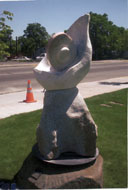
SN: Who are you?
Nicky: My name is Nicky Oberholtzer and I am an artist and sculptor. It has taken me 53 years to say that with any authority. I have always been an artist but have only been a sculptor for 17 years.

SN: Why did you become an artist?
Nicky: I graduated from Seattle Pacific University with double degrees in Fine Art and Russian while raising 2 sons and a daughter. I went back to school as an adult student with the intention of getting a degree in Psychology. I had a teacher there who showed us through his own example how badly power and psychology can be abused. Ironically, he is still the school’s pet psychologist. He made me very angry. I needed another humanities course to fulfill my credits and while looking through the art section, noticed a sculpture class. Hitting rocks! What a great way to get all that aggression towards the teacher out in a constructive manner. So I dropped Psychology, took the sculpture class and the rest is, as they say, history.
SN: How has NWSSA influenced your work as an artist?
Nicky: My sculpture teacher was a NWSSA member, and recommended that I join. My first experience was at Camp Brotherhood in 1990 and I came so close to leaving that first day. But I stayed, shy as I was and met Nancy Green, who was also there for the first time. George Pratt was one of the teachers there and became one of my mentors. Shortly after, I met Everett Dupen and studied with him. I have attended five sessions of Marble/Marble, the Indiana Limestone symposium, fourteen sessions of Camp Brotherhood and studied with a carver in the Southwest.
SN: Who or what has influenced your art?
Nicky: My biggest influences in the art world have been Brancusi, Moore, O’Keeffe, Degas, nature and no, not Michelangelo, (gasp!) Art is my life. If I go very long without doing it, my hands begin to itch for tools or a stone, a pastel or an oil brush.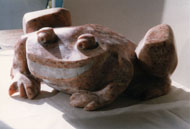
SN: What are you trying to express?
Nicky: I am trying to get people to react, to touch, to take a second look at things and forms in nature. When people reach out instinctively to touch my sculptures, even knowing that society has taught us not to touch it in museums, I have succeeded. Selling it is secondary. We are a tactile-poor society, with the exception of computers, which I am not sure is a good thing. If the observer says, “Oh, what a beautiful sculpture” then I have succeeded but if they say, “Wow, cool stone” I have failed to balance the beauty of the stone with the subject matter and the stone then dominates. But am I the carver or merely a tool? The stone talks to me and I try to do what it says to do. I am a direct carver and very rarely use maquettes. I may start with a drawing but I don’t feel that I have to execute it exactly. Rather, it is a jumping off place to begin an idea.
SN: How do you get your ideas?
Nicky: My ideas spring from nature. A curve of a shell, a bird preening or a cloud in the sky; all can trigger a new idea. I don’t like rules, and one of the first rules that I learned was that you can only do one type of subject matter well. It was said to me that galleries don’t like artists who do too many different things. I decided that I was not going to limit my subject matter to please a gallery so I do everything from nudes to form, abstraction to animals and I think that most of them turn out just fine. I enjoy doing them and that is what counts. I try to make art that anyone can relate to and feel comfortable around. My focus is to celebrate life and share it.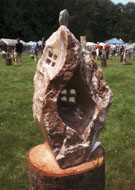
SN: What stones do you prefer?
Nicky: I carve many stones, and find them all enjoyable as long as I have the proper equipment and know what the stone is. My favorite stone to carve is granite, because it is cheap, I can get it locally and it is fairly predictable. I also like alabaster. I do large scale sculpture to exhibit in city environments. Currently, my large pieces can be found in Wenatchee, Arlington, Redmond, Marble, Colorado and Oregon City. I love working big and would like to work on even bigger scales.
SN: Where do you exhibit your work?
Nicky: I don’t currently show at any galleries because I’ve found that they really don’t seem to sell for the artist. My pieces sell better when people stop at my studio where I can talk to them about what I do and why. They always seem to leave with a piece or two or three.
SN: What is your working process; do you do one piece at a time or do you have several in process at once?
Nicky: I generally will have about 50 pieces going simultaneously as I am easily bored. I may work on as many as seven or eight in a day, doing a little here and a little there. I use everything from hand tools to electric grinders, foredoom, rotohammers and pneumatic tools. I am always looking for a better tool. My husband doesn’t worry when I go to a mall, but put me in a hardware store and he gets very worried. In a year’s time, I would guess that I probably complete at least 25 sculptures including a large one. I am fortunate that I seem to be a fast carver.
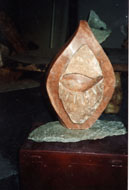
I go thru phases when all I do is start new pieces, then at other times, I just do sanding for a week or so. Then there are those times when I can’t see where I am going. That’s when I stop and move on to another stone. Sometimes, a particular stone won’t “talk” to me again for years. Then all of a sudden, one, or more, will start blabbing away and expect me to drop what I am doing and work on them again. I have found that if I keep on working on a stone when it has stopped talking to me, it will end up a mediocre piece. If I am patient, it will end up being a better sculpture.
SN: Do you teach art?
Nicky: I have taught sculpture for about 15 years. I love teaching. I taught for several years at Camp Brotherhood and Whidbey Island. I now teach on a regular basis at my studio, privately, and at several of the colleges, and at some businesses.
SN: What obstacles and challenges have you overcome?
Nicky: Fear of failure, duh! I also sometimes experience self doubt and poor self-esteem. I highly recommend a book called “Fear and Art” for people dealing with the same issues.
When I graduated from High School, my father asked me what I wanted to do with my life. I had been fortunate to be taught by a local artist in my art classes who really encouraged me to follow my passion. So I told dad I wanted to be an artist. He laughed and then said, “yeah but what do you want to do for your day job? You can’t make a living doing that!” I listened to him, and so for years stumbled around doing things that I didn’t enjoy. I still did art but basically hid it because he didn’t approve.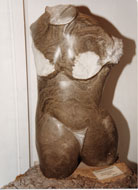
Looking back, I wonder, what would have happened had I gone into art right out of high school. When we struggle to discover ourselves and finally do, everything that we have done and become helps to direct what we create. I think that if I had pursued art at that time, I might have long since given it up and might even, God forbid, be working in an office somewhere now. If that were the case, I think I would be an unhappy person. Speaking of challenges, another big one I’m facing now is trying to build my own website.
SN: What have been your satisfactions in our life as an artist?
Nicky: One of my biggest satisfactions was selling my first big sculpture. I would love to work somewhere on site and do something REALLY big. I have many ideas for neat pieces but have too many rocks, too little time and too little energy.
SN: Describe a recent piece or two.
Nicky: HiJinx is an alabaster piece that I just completed. It was started at the Flower and Garden show last year and portrays a Polar Bear cub climbing onto his sleeping mom. It was fairly successful.
Another of my favorite ideas and pieces is Windows on the Soul. The first sculpture in this series is done in Strawberry Alabaster. The center has an open cavern upon which light reflects through two windows cut into the exterior surface. It brings to mind how we reflect our world and how the world can dominate our souls if we let it. It can be good or bad, that is the judgment we must make. I have plans to do several six to eight foot granite sculptures in this series.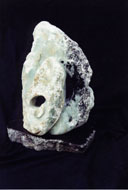
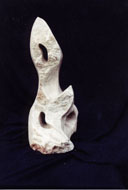
Another series I am about to start involves Inukshuks. They are the stacked stone signposts that the Innuits of Canada use to navigate their icy world during the winter, since they do not have natural points of reference to travel by. Several years ago I was fortunate to be able to study with 20 Innuit carvers and their families for three weeks. Everywhere we traveled, they built little people forms (Inukshuks) by stacking stones. These guideposts have intrigued me for years. I have a design for a hitchhiking Inukshuk. My little people forms will involve both carving and stacking, and I see them as a real challenge.
Nicky: Finally I want to thank my students, who have taught me, my teachers who have been patient with me and encouraged me and mostly my husband who supports me in most everything that I attempt. Without him, I couldn’t do a lot of what I do. In conclusion, I want to thank God for bestowing a talent on me that is my life’s blood, giving me both joy and trials. Every new day is a challenge waiting to be faced and conquered.

